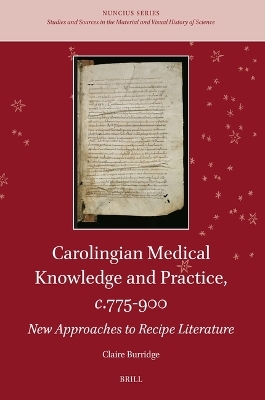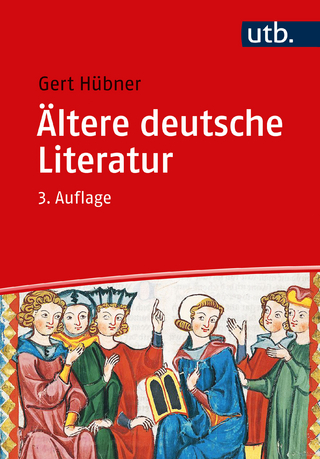
Carolingian Medical Knowledge and Practice, c.775-900
Brill (Verlag)
978-90-04-46616-6 (ISBN)
Carolingian Medical Knowledge and Practice explores the practicality and applicability of the medical recipes recorded in early medieval manuscripts. It takes an original, dual approach to these overlooked and understudied texts by not only analysing their practical usability, but by also re-evaluating these writings in the light of osteological evidence. Could those individuals with access to the manuscripts have used them in the context of therapy? And would they have wanted to do so? In asking these questions, this book unpacks longstanding assumptions about the intended purposes of medical texts, offering a new perspective on the relationship between medical knowledge and practice.
Claire Burridge is a Senior Researcher at the University of Oslo, having previously held postdoctoral fellowships at the British School at Rome and a Leverhulme Trust Early Career Fellowship at the University of Sheffield.
Acknowledgements
List of Figures and Tables
Abbreviations
Note on Transcription and Translation
Note on Weights, Measures, and Their Symbols
Map
Introduction
1 Practicality and Applicability A Dual Approach to Carolingian Medical Knowledge and Practice
1 Introduction: the Case of Terenti(an)us
2 Definitions
3 Foundations
4 A Philological Underpinning
5 Histories of Early Medieval Medicine: from Negative Stereotypes to Revisionist Approaches
6 New Directions in Early Medieval Medical Research
7 Summary
8 The Carolingian Context
9 Structuring the Dual Approach
Part 1
Practicality
2 Setting the Scene The Texts, Their Contexts, and the Need for a Re-examination of Practicality
1 Introduction: a Mixed Picture of (Im)practicality
2 Contextualising Medicine’s Place in Early Medieval Europe and the Question of Practicality
3 Summary
4 Outlining the Recipe Literature
5 Recipes and Recipe Collections
6 The Manuscript Sample
3 Impossible Imports or Available Exotics? A Study of Non-local Materia Medica
1 Introduction: the Exotic Ingredients of an Antidote
2 Evidence for the Movement of Non-local Materia Medica
3 Exotic Materia Medica
4 What’s in a Name? The Challenge of Identifying Ingredients and Their Origins
5 From Ambergris to Zedoary
6 The Confectio Timiame: Camphor, Ambergris, and Other Non-local Materia Medica
7 The Recurrent Cluster: Parallels among Incense Recipes
8 Moving beyond Incense: the Spread of Knowledge
9 The Practicality of Non-local Materia Medica: Putting the Case Study in Perspective
10 Conclusion
4 Medicine and the Mead Hall? Using Alcoholic Beverages to Explore Potentially Local Materia Medica
1 Introduction: a Snapshot from cod. sang. 752
2 Wine, Beer, and Mead in the Classical Mediterranea
3 Changing Tastes in Late Antiquity?
4 The Rise of Beer and Medus in the Early Middle Ages
5 Beer
6 Mead and Medus
7 Summary
8 Contextualising Beer and Mead in Early Medieval Europe
9 Beer, Mead, and the Question of Practicality
10 Conclusion
5 Evidence for Practicality beyond Materia Medica
1 Introduction: the Importance of Investigating Additional Elements within Recipes
2 Staupus: a Vernacular ‘Intrusion’
2.1 Past Studies on Staupus
3 The Appearance of Staupus in the Recipe Sample
4 The Absence of Staupus in Texts on Weights and Measures
5 The Practicality of the Unit Staupus
6 Wild versus Cultivated Rue: the Inclusion of an Ingredient Substitution
7 Instructions for Ingredient Substitutions in the Recipe Sample
8 Ingredient Substitution in Earlier Sources
9 The Practicality of Substitution Instructions in Recipes
10 Conclusion
Part 2
Applicability
6 Reading Recipes in the Light of Skeletal Remains An Introduction to the Integration of Osteological Evidence
1 Introduction: Moving from Practicality to Practice, an Investigation into Applicability
2 Establishing the Framework of Part ii
2.1 Why Question the Relevance of Recipes?
3 Working with the Available Evidence
4 The Challenges of Using Osteological Evidence to Inform Textual Analysis
4.1 Intrinsic Issues with Archaeological Evidence
5 Theoretical Challenges Related to the Integration of Skeletal Evidence
5.1 Retrospective Diagnosis
5.2 The Osteological Paradox
5.3 Selection of Conditions
5.4 Absence of Evidence as Evidence of Absence?
6 Outlining the Analytical Approach to Chapters 7–9
6.1 Overview of Sites
6.2 The Spectrum of Specificity
7 Dental Disease From Caries to Cosmetics
1 Introduction: a Monk from Lorsch
2 Oral Health in the Skeletal Evidence
3 Dental Disease in the Archaeological Record: an Overview
4 Skeletal Evidence for Oral Pathologies in Early Medieval Europe
5 Recipes to Treat Dental Disease
6 Category 1: Toothache
7 Categories 2–6: the Other Half of the Recipes Concerning Oral Health
7.1 Category 2: Ulcers, Sores, Wounds, and Burns
7.2 Category 3: Cavities and Tooth Loss
7.3 Category 4: Putridity and Cosmetics
7.4 Category 5: General, Unspecified Mouth Complaints
7.5 Category 6: Gum Problems
8 Summary
9 The Applicability of the Recipe Sample to Early Medieval People
10 Specific Types of Teeth
11 Specific Types of People
12 Cosmetics
13 Possible Sources for Dental Recipes
14 Conclusion
8 Joint Disease Problematising Podagra
1 Introduction: the Pains of Gout—and the Problems of Translation
2 The Appearance of Podagra in Medical Recipes
3 The Absence of Gout in Archaeological Contexts
4 Moving beyond Gout: Evidence for Other Arthropathies in the Osteological Record
5 The Spine
6 Large Joints and limbs: Shoulders, Elbows, Hips, and Knees
7 Small Joints: Hands and Feet
8 Summary
9 Textual Evidence for Joint Pain beyond Podagra
10 General Afflictions of the Joints
11 Named Joints and Joint Areas: the Back, Neck, Shoulders, Hips, Knees and Hands
12 Integrating the Evidence: a Return to the Gout-Podagra Paradox and the Question of Applicability
13 Gout versus Podagra: Conflicting Evidence or a Modern Misnomer?
14 The Question of Applicability
15 Conclusion
9 Trauma and Surgery Evidence of Undocumented Medical Practices?
1 Introduction: Interventions ‘Without Ron’
2 Textual Evidence for Invasive Surgery and Trauma
2.1 Surgery
2.2 Trauma
3 Osteological Evidence for Trauma and Surgery
3.1 Identifying and Understanding Trauma in the Osteological Record
3.2 Evidence for Trauma in Early Medieval Skeletal Remains
4 Reading Recipes in the Light of Osteological Evidence for Trauma and Surgery
4.1 Type of Injury: Conflicting Evidence?
4.2 The Question of Surgery
4.3 Evidence for Trauma beyond Medical Texts
5 Conclusion
Conclusion
10 Putting Knowledge into Practice
1 Introduction: Revisiting the Case of Terenti(an)us
2 Bringing Together the Case Studies
3 Moving Forward: Final Remarks and Future Directions
Appendices
Appendix 1 The Manuscript Sample
Appendix 2 Recipe Transcriptions
Bibliography
Index of Materia Medica Named in Recipes
General Index
| Erscheinungsdatum | 22.08.2024 |
|---|---|
| Reihe/Serie | Nuncius Series ; 14 |
| Verlagsort | Leiden |
| Sprache | englisch |
| Maße | 155 x 235 mm |
| Gewicht | 847 g |
| Themenwelt | Geschichte ► Allgemeine Geschichte ► Mittelalter |
| Geisteswissenschaften ► Geschichte ► Regional- / Ländergeschichte | |
| Studium ► Querschnittsbereiche ► Geschichte / Ethik der Medizin | |
| ISBN-10 | 90-04-46616-9 / 9004466169 |
| ISBN-13 | 978-90-04-46616-6 / 9789004466166 |
| Zustand | Neuware |
| Haben Sie eine Frage zum Produkt? |
aus dem Bereich


